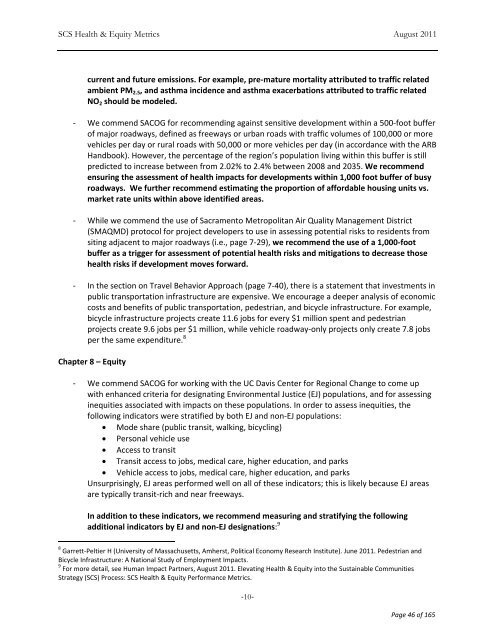Draft MTP/SCS Comments Received - sacog
Draft MTP/SCS Comments Received - sacog
Draft MTP/SCS Comments Received - sacog
You also want an ePaper? Increase the reach of your titles
YUMPU automatically turns print PDFs into web optimized ePapers that Google loves.
<strong>SCS</strong> Health & Equity Metrics August 2011<br />
current and future emissions. For example, pre‐mature mortality attributed to traffic related<br />
ambient PM 2.5 , and asthma incidence and asthma exacerbations attributed to traffic related<br />
NO 2 should be modeled.<br />
‐ We commend SACOG for recommending against sensitive development within a 500‐foot buffer<br />
of major roadways, defined as freeways or urban roads with traffic volumes of 100,000 or more<br />
vehicles per day or rural roads with 50,000 or more vehicles per day (in accordance with the ARB<br />
Handbook). However, the percentage of the region’s population living within this buffer is still<br />
predicted to increase between from 2.02% to 2.4% between 2008 and 2035. We recommend<br />
ensuring the assessment of health impacts for developments within 1,000 foot buffer of busy<br />
roadways. We further recommend estimating the proportion of affordable housing units vs.<br />
market rate units within above identified areas.<br />
‐ While we commend the use of Sacramento Metropolitan Air Quality Management District<br />
(SMAQMD) protocol for project developers to use in assessing potential risks to residents from<br />
siting adjacent to major roadways (i.e., page 7‐29), we recommend the use of a 1,000‐foot<br />
buffer as a trigger for assessment of potential health risks and mitigations to decrease those<br />
health risks if development moves forward.<br />
‐ In the section on Travel Behavior Approach (page 7‐40), there is a statement that investments in<br />
public transportation infrastructure are expensive. We encourage a deeper analysis of economic<br />
costs and benefits of public transportation, pedestrian, and bicycle infrastructure. For example,<br />
bicycle infrastructure projects create 11.6 jobs for every $1 million spent and pedestrian<br />
projects create 9.6 jobs per $1 million, while vehicle roadway‐only projects only create 7.8 jobs<br />
per the same expenditure. 8<br />
Chapter 8 – Equity<br />
‐ We commend SACOG for working with the UC Davis Center for Regional Change to come up<br />
with enhanced criteria for designating Environmental Justice (EJ) populations, and for assessing<br />
inequities associated with impacts on these populations. In order to assess inequities, the<br />
following indicators were stratified by both EJ and non‐EJ populations:<br />
Mode share (public transit, walking, bicycling)<br />
Personal vehicle use<br />
Access to transit<br />
Transit access to jobs, medical care, higher education, and parks<br />
Vehicle access to jobs, medical care, higher education, and parks<br />
Unsurprisingly, EJ areas performed well on all of these indicators; this is likely because EJ areas<br />
are typically transit‐rich and near freeways.<br />
In addition to these indicators, we recommend measuring and stratifying the following<br />
additional indicators by EJ and non‐EJ designations: 9<br />
8 Garrett‐Peltier H (University of Massachusetts, Amherst, Political Economy Research Institute). June 2011. Pedestrian and<br />
Bicycle Infrastructure: A National Study of Employment Impacts.<br />
9 For more detail, see Human Impact Partners, August 2011. Elevating Health & Equity into the Sustainable Communities<br />
Strategy (<strong>SCS</strong>) Process: <strong>SCS</strong> Health & Equity Performance Metrics.<br />
‐10‐<br />
Page 46 of 165
















